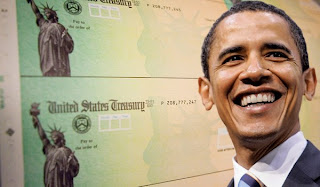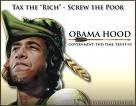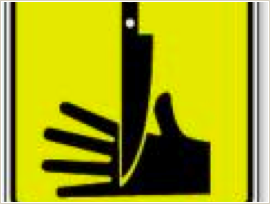
I should be happy because I am effectively hedged and have done well since the market peaked in October. I’m only down a few bucks, am sitting on lots of liquidity, and am ready for any buy signal that makes sense. But being hedged and keeping money isn’t the same as making money. Making money is exciting, breaking even is dull.
Given today’s large move, should an investor put cash to work and ride equities upward? Today’s catalyst was UBS’ loss of billions and their decision to dilute their shareholders by issuing replacement capital! To top that decision, they got rid of the offending CEO and made their General Counsel the new chief! So on that wonderful news the markets took off. We’ve seen this numerous times and they have always backed off. Will this time be different?
Let’s look at what could cause the markets to move upward and stay up.
1. Earnings are good for the 1st quarter and guidance isn’t depressing, merely cautionary.
2. Commodities take a dramatic and sustained move down, easing cost pressures on businesses and consumers.
3. The current disconnect between bonds and stocks is corrected by yields lowering still and allowing P/Es to expand.
4. Europe and Asia show that they truly are decoupled from the US economy and US exporters provide vigorous guidance.
5. Companies regain confidence and decide to continue to support their stock price by using their cash and new debt to repurchase shares as opposed to conserving cash in tough times.
6. Hedge Funds and Private Equity find a way to continue to employ huge amounts of leverage to continue business as usual.
7. The consumer proves to be resilient, continues to find credit and uses it, rather than taking a breather and foregoing un-necessary purchases.
8. The Fed’s rate cuts and the President’s stimulus package work perfectly and banks continue to lend and consumers continue to spend.
9. The Fed announces that all banks, investment banks, insurance companes, and large pools of capital have taken all their losses and remain well capitalized.
10. Housing starts drop to a level that inventory starts dropping and
the glut starts clearing, leading to a potential rebound in building and employment.
11. Commercial real estate doesn’t slow and CMDOs don’t develop into a problem area.
12. The consumer is able to handle his home equity line and credit cards without the ability to refinance.
If all twelve occur we are off to the races. If half develop we will continue to tread water as we have lately. If only a few of the above items materialize the market will go lower, for a longer period and breaking-even will feel wonderful, not like kissing your sister.
Since I write these missives to myself to see if I’m thinking logically, let’s go through the twelve for my take on the odds.
1. Freight is down, housing is down, recreation is down, financials are cutting back, costs are sky rocketing. S & P earnings will be poor, analysts’ estimates will be reduced and there will be lots of hedging on guidance, very few clear views of the next 9 months.
2. Recessions usually take care of cost pressures through lack of demand, but with a weak dollar and many commodities in unstable lands we may see pricing stay high longer than in the past. Agricultural pricing looks fixed for the next several years putting pressure on food prices. Any admission that inflation is higher than the CPI and commodities will soar.
3. Yields are going to increase as the credit crisis wanes and investors see that we are just in a slowdown, not disaster. Then they will demand greater rates to compensate for inflation.
4. This will help, but the UK is slowing now and Europe won’t be far behind. Guidance from multi-nationals will not be robust.
5. These guys aren’t stupid, they will conserve cash as they’ve seen companies like Bear Stearns go down overnight when credit gets pulled. The days of huge stock buybacks to disguise option grants, juice eps, and keep share price up are over. Conserving cash and reducing debt is the tactic du jour for the time being.
6. The banks won’t let them and the Fed will be watching the banks. The days of huge leverage are behind us. Margin requirements will be tightened and covenants strengthened at any opportunity. Steely-eyed bankers will return.
7. The consumer is tapped. Wages haven’t kept pace with costs and consumers have made ends meet by refinanceing and borrowing. Those days are over because securitization is over. The car business may be next as they were writing 8 year loans and that phenomenom may be close to over as those credits won’t be allowed on balance sheets and nobody wants to buy them in this climate. Credit card delinquencies and losses have been OK, but they will come under pressure also as lenders tighten up.
8. Banks are collecting, not lending and consumers will send their stimulus checks to credit card companies giving them and the creditors some respite. There won’t be many goods purchased with the money.
9. There are more losses to come and huge amounts of loan loss provisioning resulting in continued pressure on bank earnings and capital.We are not in the 8th inning of bank problems.
10. Inventory is still growing as builders haven’t reduced starts enough yet. House prices are still unaffordable for many in this country. Therefore prices need to come down further or wages need to increase. The spill over of depressed housing will continue to affect many other industries.
11. Commercial real estate growth will taper off, but probably won’t fall off a cliff like housing. Thus the CMDOs will be mostly OK.
12. Credit cards will be the next bad area after we get through mortgages and HELOCs. The stimulus payments will postpone this reconing till mid- summer.
I’ve convinced myself that things aren’t going to get better quickly. We are in a consumer led problem and this will not be solved by government programs. The problem developed as wages didn’t keep up with expectations and that shortfall was made up with borrowing, mostly against real estate. Now the ability to borrow has diminished significantly and the consumer’s spending patterns will change as a result. The consumer is a huge portion of our GNP and the reduced spending will have a dramatic impact on corporate earnings.
The problem that bubbled up through subprime will be with us for quite some time and stock prices will not march upward quickly.
 Of late I've felt as if I was Beldar Conehead. Over the Holidays I've consumed "mass quantities" of food and swallowed beer by the six-pack. Additionally, I'd feel comfortable saying I too was from France, as Beldar regularly answered, since our politicians are inserting the government into more and more aspects of corporate America. We may soon be more French than the French.
Of late I've felt as if I was Beldar Conehead. Over the Holidays I've consumed "mass quantities" of food and swallowed beer by the six-pack. Additionally, I'd feel comfortable saying I too was from France, as Beldar regularly answered, since our politicians are inserting the government into more and more aspects of corporate America. We may soon be more French than the French.



































